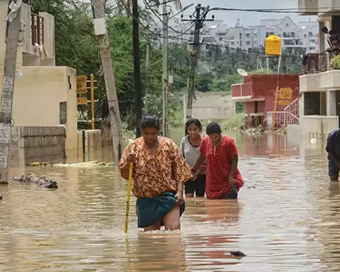 PM Modi visit USA
PM Modi visit USA Only the mirror in my washroom and phone gallery see the crazy me : Sara Khan
Only the mirror in my washroom and phone gallery see the crazy me : Sara Khan Karnataka rain fury: Photos of flooded streets, uprooted trees
Karnataka rain fury: Photos of flooded streets, uprooted trees Cannes 2022: Deepika Padukone stuns at the French Riviera in Sabyasachi outfit
Cannes 2022: Deepika Padukone stuns at the French Riviera in Sabyasachi outfit Ranbir Kapoor And Alia Bhatt's Wedding Pics - Sealed With A Kiss
Ranbir Kapoor And Alia Bhatt's Wedding Pics - Sealed With A Kiss Oscars 2022: Every Academy Award Winner
Oscars 2022: Every Academy Award Winner Shane Warne (1969-2022): Australian cricket legend's life in pictures
Shane Warne (1969-2022): Australian cricket legend's life in pictures Photos: What Russia's invasion of Ukraine looks like on the ground
Photos: What Russia's invasion of Ukraine looks like on the ground Lata Mangeshkar (1929-2022): A pictorial tribute to the 'Nightingale of India'
Lata Mangeshkar (1929-2022): A pictorial tribute to the 'Nightingale of India' PM Modi unveils 216-feet tall Statue of Equality in Hyderabad (PHOTOS)
PM Modi unveils 216-feet tall Statue of Equality in Hyderabad (PHOTOS)The Badminton Association of India (BAI) has announced a 14-member-strong India squad for
- Men’s Sr Hockey Nationals to be played in division-based format from April 4
- Mensik denies Djokovic 100th title in Miami final
- KIPG: Son of a vegetable vendor, Bihar’s Jhandu Kumar eyes Worlds, 2028 Paralympics
- Hardik Singh credits hard work and team unity for receiving HI Midfielder of the Year award
- Djokovic, Alcaraz land in same half of Miami draw
Women winning fewer elections, losing deposits in larger numbers : Uttar Pradesh Last Updated : 14 Feb 2017 03:48:58 PM IST 
(File Photo)
Poor, populous Uttar Pradesh was the first state to have a female Chief Minister -- Sucheta Kriplani from 1963 to 1967 -- but this pioneering effort has not improved prospects for women in elections.
As voter turnout has risen, more competitors have stood against women candidates, fewer women have won and a growing number have lost their deposits, according to an IndiaSpend and Swaniti Initiative analysis of electoral data of the three state elections since 2002.
The only exception was for the seats reserved for Scheduled Caste (SC) candidates. The proportion of women winning SC seats was more than double that of those winning general seats.
All this happened over a period when women in India's most populous state became healthier and better educated, reinforcing the point that there is no correlation between these indicators and better political representation of women.
States with the worst sex ratios have more women members of legislative assemblies (MLAs).
Roughly over the same period of our study, female literacy in Uttar Pradesh grew from 42.2 per cent in 2001 to 59.3 per cent in 2011, and the sex ratio improved from 898 to 908, according to census data compiled by the NITI Aayog.
Women also became less anaemic and had fewer chances of dying during childbirth. The state's maternal mortality ratio (MMR) -- an indicator of general health progress -- declined from 440 deaths per 100,000 live births in 2004-06 to 285 in 2011-13.
In general, there appears to be a surge in women contestants in elections, but we found that a growing number in Uttar Pradesh are forfeiting deposits, which means they could not garner a sixth of valid votes polled in their constituencies.
This is used as an excuse by political parties to field fewer women candidates, which further reduces their political opportunities.
How does this work?
To answer the question, we analysed data from the previous three assembly elections by: Comparing the percentage of female candidates who had to forfeit their deposits in general and reserved seats for SCs; and the proportion of victorious candidates ' title=' women candidates '>women candidates from general and reserved seats.
We sought to explore if a higher voter turnout jeopardises the chances of candidates ' title=' women candidates '>women candidates in seats of both categories.
There were 314 general and 89 SC seats for the 2002 and 2007 assembly elections, while in 2012 there were 318 general and 85 SC seats. The turnout in 2002 was 53.8 per cent; 45.95 per cent in 2007; and 59.52 per cent in 2012.
The proportion of female candidates who saved their deposits -- in other words, won enough votes to be taken seriously -- was higher when they contested from seats reserved for SCs.
In 2002, women won 11 of 314 seats (3.5 per cent) for general-category candidates, and 15 of 89 seats (16.9 per cent) reserved for SCs. By 2012, women won 22 of 318 general seats (6.9 per cent) and 13 of 85 reserved seats (15.3 per cent). So, women contesting from SC seats had a more than double chance of winning.
There was a larger voter turnout in general seats than reserved seats in the three elections we analysed. This implies one of two things: That candidates ' title=' women candidates '>women candidates may not be favoured by the electorate or that gender is not a factor in voting decisions.
The Women's Reservation Bill [The Constitution (108th Amendment) Bill, 2008], which was passed by the Rajya Sabha, lapsed in 2014 with the dissolution of the 15th Lok Sabha. The Bill called for the reservation of a third of seats for women in the parliament and the state legislative assemblies, but it has met with widespread resistance from male politicians.
Since 2001, at least 14 political parties with a women-oriented political agenda have emerged across India. Five of these parties had contested either a general election or a state assembly election in the past 15 years, according to statistical reports of elections to the Lok Sabha and state assemblies.
Despite a low success rate (with 100 per cent deposit forfeited in all cases), most of these parties have survived, and the trend of registration of women's issues-based parties has increased over the years, in a country where women comprise no more than 11.4 per cent of the parliament.IANS For Latest Updates Please-
Join us on
Follow us on








172.31.16.186







